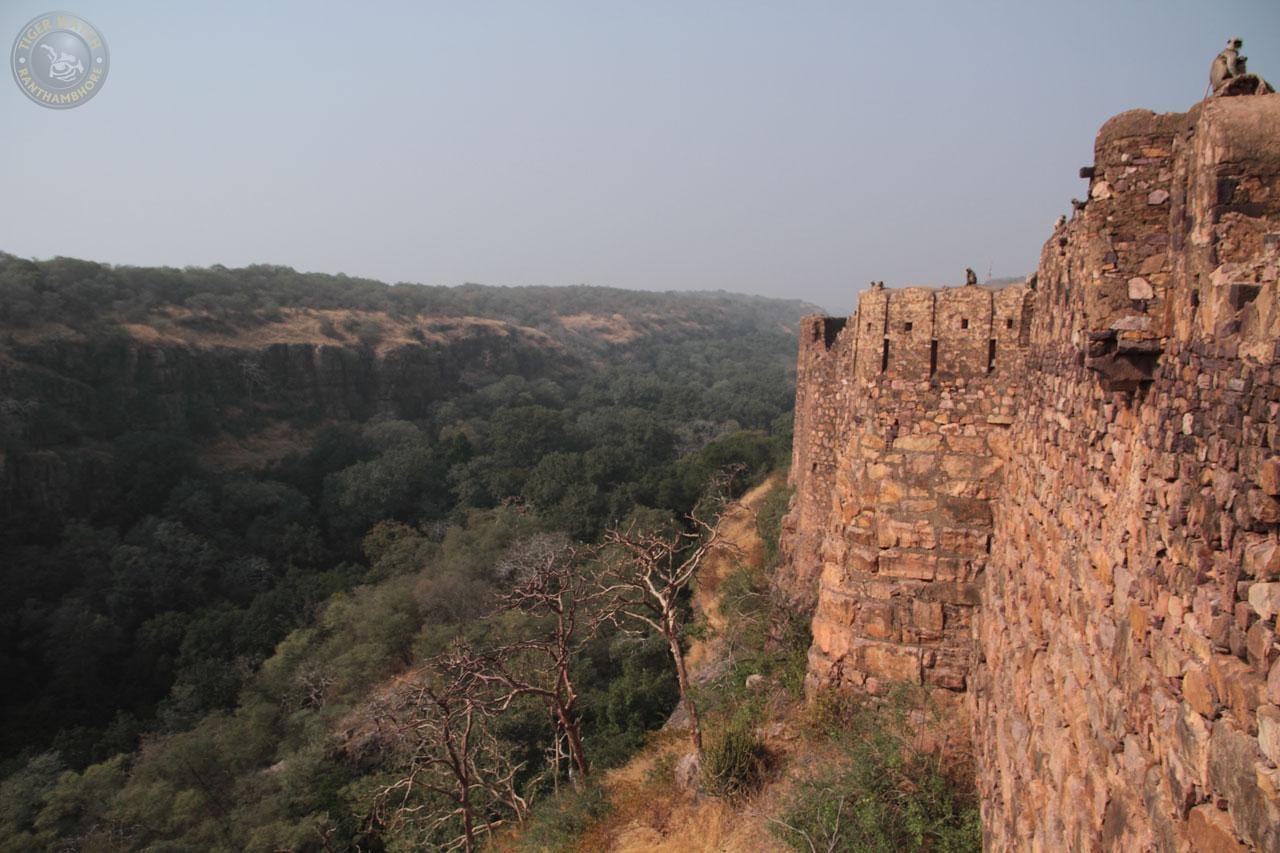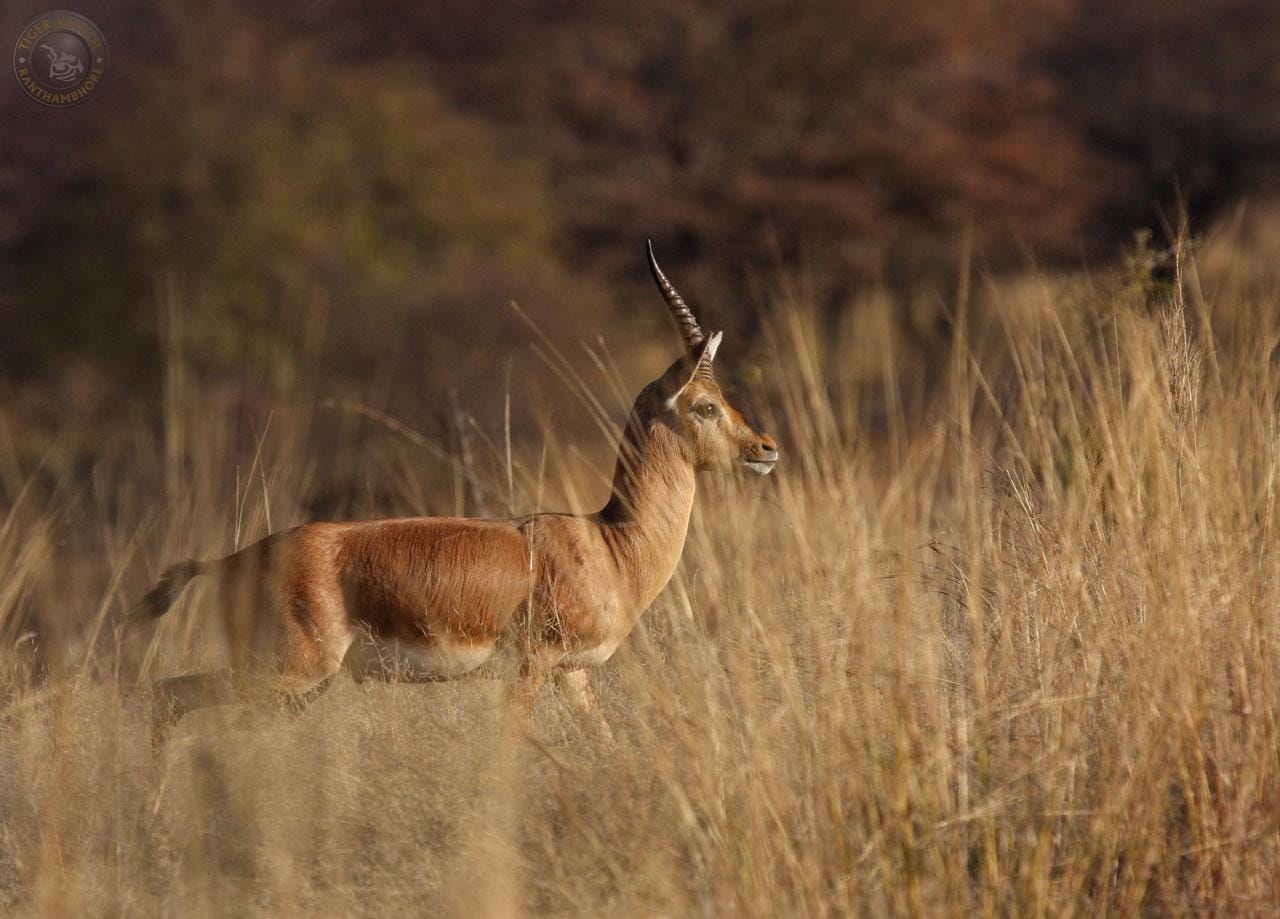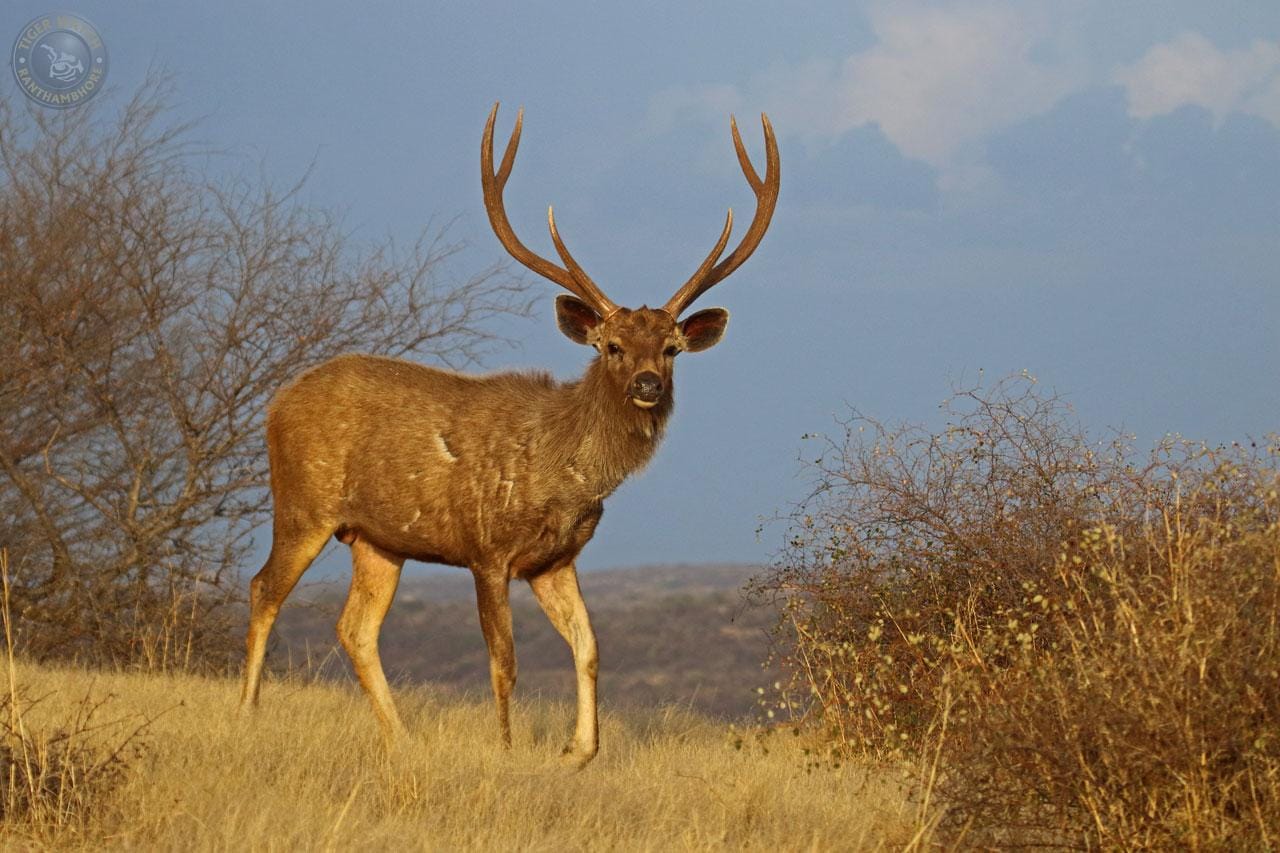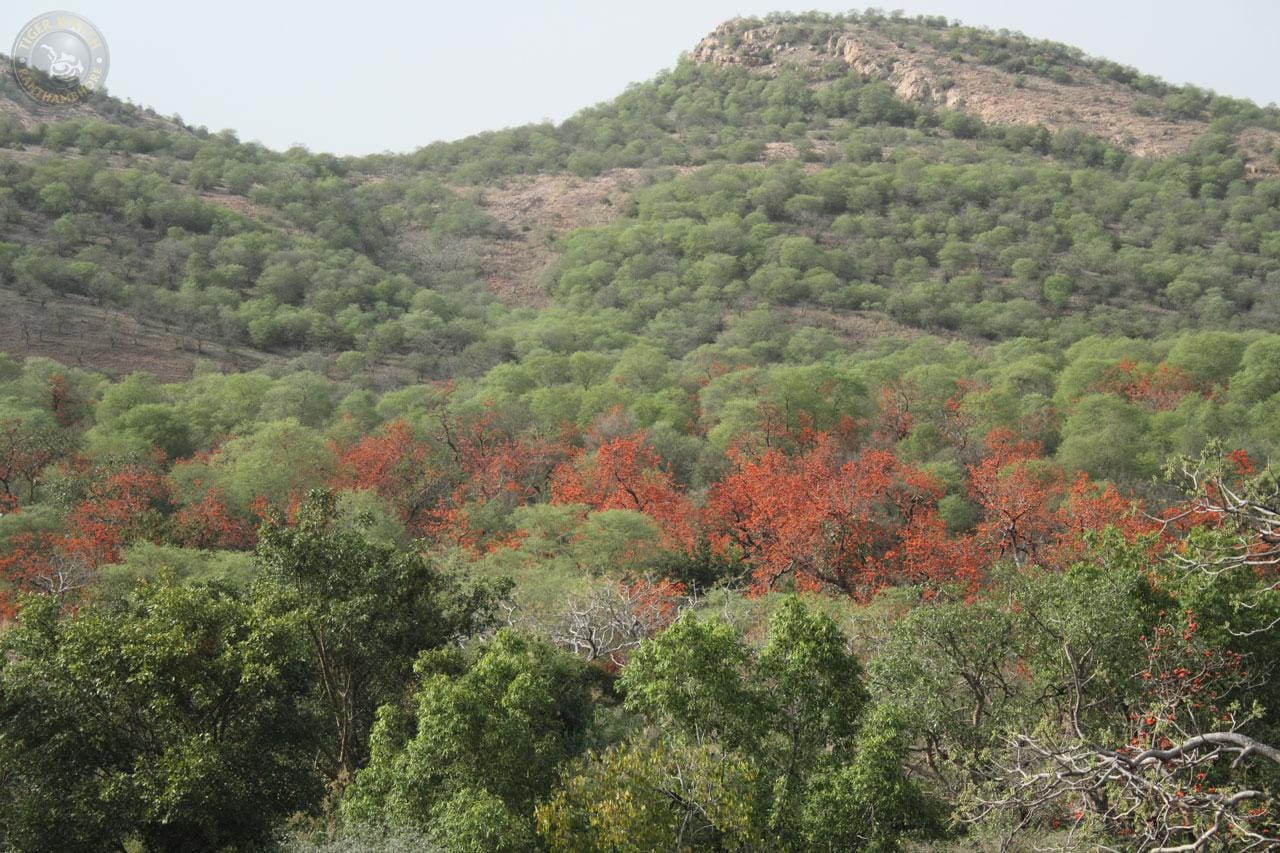Where We Work
Ranthambhore Tiger Reserve is famous for its tigers and stunning landscapes, where history and natural history blend seamlessly. It is the best place for sighting tigers in the wild, because it is the world’s driest and hottest tiger habitat. Few water sources and sparse vegetation increase the chances of sighting tigers and this makes Ranthambhore the most popular destination on India’s tiger tourism map. Visitors may only know about the grandiose Ranthambhore fort, but the landscape is home to numerous old forts and some of them are much older than the 10th century fort! Ranthambhore has been explored mostly with the tiger in mind, but it has many other undiscovered facets that Tiger Watch has slowly been able to establish.
Ranthambhore is in the eastern part of India’s largest state – Rajasthan. This is the world’s driest tiger habitat because temperatures fluctuate between 1⁰ C to 48⁰C and rainfall is erratic with an annual average between 600 and 900 mm. Hill ranges, perennial and monsoon rivers, undulating ravines and plains make the area suitable for many different species. The Aravalli hill range is one of the chief attributes of Ranthambhore. In existence for over 4 Bya., this is one of the oldest hill ranges in the world. The range was formed in a series of cratonic collisions between the Bundelkhand craton and the Marwar craton. Initially, this range was a lot more imposing but wind and water eroded it to the present 400 to 500 meters height. The terrain is comprised of Pre- Cambrian metamorphic, igneous and sedimentary rocks. The other hill range in Ranthambhore is the Vindhyan which is also very old, dating back to around 2.5 Bya. The Vindhayan hill range was developed due to a special geographical phenomenon called geosyncline. There was a massive geosyncline called Bijawar geosyncline that folded the sediments forming the Vindhayan range. They were Fold Mountains but continued denudation with the passage of time eroded them to escarpments. The process of erosion is still going on. The Vindhayan hill range is comprised of sandstone, shales, limestone and breccia. Around 70 Mya old, the Himalaya is much younger than both these hill ranges.
Ranthambhore Tiger Reserve is a 170-km-long strip of forest which is hardly 10-12 km in width. Four protected areas come under the umbrella of the Ranthambhore Tiger Reserve. These are the Ranthambhore National Park, Kailadevi Wildlife Sanctuary, Sawai Madhopur Wildlife Sanctuary and Sawai Mansingh Wildlife Sanctuary. Before becoming a protected habitat, Ranthambhore was one of the famous hunting grounds of the Maharajas of Jaipur. Ranthambhore, was established as the Sawai Madhopur Game Sanctuary in 1955 by the government and was declared a Project Tiger Reserve in 1973 and then became known as Ranthambhore Tiger Reserve. The central part of Ranthambhore became a national park on 1st November 1980. The Sawai Madhopur Game/Wildlife Sanctuary is still on the peripheral region of the National Park. The adjoining large forest of the district of Karauli was declared as the Kailadevi Wildlife Sanctuary on 19th July 1983. To the south, the forests of Sawai Madhopur were notified as the Sawai Mansingh Wildlife Sanctuary on 30th November 1984. In 1991, the Tiger Reserve was expanded to include the Sawai Man Singh and Kailadevi Sanctuaries. There is a fifth protected area — National Chambal Sanctuary — which overlaps with the Tiger Reserve near the Sanwati forest block and some parts of the Kailadevi Wildlife Sanctuary, but the Chambal is not considered a part of the Tiger Reserve on the government documents.

Geography
The total area of Ranthambhore Tiger Reserve is 1700.22 sq.km, which is divided like 738.61 sq.km in Sawai Madhopur district, 765.30 sq.km area under Karauli district, 187.30 sq.km area under Bundi district, 9.03 sq.km under Tonk district of Rajasthan. Area of Ranthambhore National Park with Sawai Madhopur Sanctuary and some reserve forest is 392.5 sq.km, Kailadevi Wildlife Sanctuary is 674 sq.km, Sawai Mansingh Wildlife Sanctuary is 127.6 sq.km and Kawalji Closed Area is 7.58 sq. km. For the purpose of management, the Tiger Reserve is divided into critical tiger habitat (CTH) and a buffer zone. In RTR , the total CTH area is 1113.36 sq.km and comes under two divisions, -636.24 sq.km. area under the Sawai Madhopur division and 477.12 sq.km area under the Karauli division. The scattered buffer areas add up to 297.92 sq.km. There is no specific status ( neither buffer nor CTH) according to a large part of the tiger reserve, which includes 288.93 sq.km. of the Ranthambhore Tiger reserve in 11 ranges — Range of Project Tiger (ROPT), Kundera, Khandar, Talra, Phalodi, Baler, Indergarh, Neniyaki, Karanpur, Mandaril and Kailadevi . These too fall under two forest divisions, Ranthambhore and Kailadevi.
Tiger Watch has thoroughly explored the Ranthambhore Tiger Reserve, National Chambal Sanctuary, and the adjoining areas, such as the Bhagwat forest, Malarna forest and Bonli forest. Tiger Watch has also explored various rivers such as the Banas, Mez, Morel, Galwa, Kanduli, Kharad, Kalisil, Bansda, Chakal and Lodkiya, and prominent water bodies of Ranthambhore such as the Surwal lake (SM), Pancholas lake (SM), Devpura Dam (SM), Gilai Sagar (SM), Mansarover Dam (SM), Gudha Dam (Bundi), Khani Dam (Bundi), Arjunpura Dam (Bundi), NIdar Dam (Karauli), Kalisil (Karauli), and Pachna Dam (Karauli) etc. We call this landscape Greater Ranthambhore. The protected area of Ranthambhore is supported by the special attributes of the surrounding landscapes. The neglected Kailadevi WLS is the main feature of Greater Ranthambhore. Kailadevi is named after the famous temple of Kaila Mata (An Indian Goddess) near the main gate of the sanctuary. Once very popular among bandits, the temple is today visited by 5 million people annually, mainly from Rajasthan, Uttar Pradesh and Madhya Pradesh. The Vindhayan Hill range is the chief geographical feature of this sanctuary which is mostly a combination of elevated table tops (Dang) or deep gorges (Kho). Some of these gorges — Handiya Kho, Dangda Kho, Ghanteshwar Kho, Mahadev Kho, Chuhaki Kho, Mahal Kho, Khadin Kho, Gadigaon Kho, Kased ki Kho, Jakhoda ki Kho, Bhereth Ki Kho, Baghpur Kho, Moilaki Kho, Tode ki Kho, Dompur Ki Kho, Damoh Kho, Ladikira Ki kho, Kedar Ki Kho, Chirmil Kho, Tapkana Ki Kho, and Kudka Kho – present a stunning sight. When large tracts of the Vindhayan hill tops (Dangs) get flooded in the monsoon, they discharge water through the gorges (Khos) and the phenomena of water erosion creates stunning canyons. The gorges are also perineal water sources for animals and Tiger Watch has ascertained that they have very good potential to sustain growing populations of tigers.
Only 2.9% area of the state is notified under 38 Protected Areas (3 national parks, 25 wildlife sanctuaries, and 10 conservation reserves). The area covered by tiger reserves in Rajasthan is just 1.07% of the state’s geographical expanse. Many believe that the Ranthambhore landscape is isolated with no connectivity with other forest landscapes. In reality, Tiger Watch’s tiger monitoring exercises have revealed that the Ranthambhore Tiger Reserve is connected with the various neighbouring forests such as the Kuno-Palpur Wildlife Sanctuary in the east, Mukundra Hills Tiger Reserve & the Ramgarh Vishdhari WL Sanctuary in the south, and the Van Vihar WLS in the north-east. The nearest distinct tiger population, however, is 450 km away in the Panna Tiger Reserve (MP), because the other closest tiger population is in Sariska Tiger Reserve but it was repopulated with tigers sourced from Ranthambhore after the local extinction experienced by Sariska in 2004.

Fauna
The Ranthambhore landscape has about 15 main rivers and rivulets that criss-cross the landscape and meet the mighty Chambal River flowing along the entire stretch of the reserve. Each river provides a set of species access to the Ranthambhore landscape. For example, the Morel River flows from central Rajasthan to Ranthambhore and offers a channel to various desert species such as Indian Desert Monitor lizard (Varanus griseus koniecznyi), Indian fringe-fingered lizard (Acanthodactylus cantoris), Indian long-eared hedgehog (Hemiechinus collaris) and White-footed fox (Vulpes vulpes pusilla). The Banas River also brings along many different species, such as the Indian hedgehog (Paraechinus micropus), Indian star tortoise (Geochelone elegans), Monster desert cricket (Schizodactylus monstrosus) etc., from the western side of Rajasthan. Other rivers, like the Kalisil, come from the eastern side, while some, while the Mez, flows from the western side. These rivers make a water network in the Aravalli and Vindhayan hill ranges like blood vessels flowing in a body.
The undulating river banks make a very fascinating ravine ecosystem. These areas function as grazing land for livestock and are also home for many wild species such as the Indian ratel (Mellivora capensis indica) and the critically endangered Indian pangolin (Manis crassicaudata).
The natural variation in all these landscapes and ecosystems makes the Greater Ranthambhore spectacularly biodiverse. Over the span of fifteen years, Tiger Watch has documented 54 species of mammals, 352 species of birds, 26 species of snakes, 20 species of lizards, 7 species of amphibians, 52 species of butterflies, and 85 species of spiders from this area whereas the Botanical Survey of India documented 539 plant species.
Among mammalia, seven different species of cats exist in the area. The world’s biggest cat Tiger (Panthera tigris tigris) is the apex predator. Next in the hierarchy is the Indian Leopard (Panthera pardus fusca), which acts as a co-predator. There is a single camera trap photo record of a Fishing cat (Prionailurus viverrinus). This is also home to the rare Asiatic caracal (Caracal caracal schmitzi), of which Tiger Watch has the most extensive data, and Jungle cat (Felis chaus prateri), the commonest of all small cats. The tough Asiatic wildcat (Felis silvestris ornata), and smallest cat of the world Rusty spotted cat (Prionailurus rubiginosus rubiginosus) are also found here. Four canidae species – Indian wolf (Canis lupus pallipes), Golden jackal (Canis aureus), Indian fox (Vulpes bengalensis) and White footed fox (Vulpes vulpes pusilla) also share the Ranthambhore landscape.
Two civets are found in Ranthambhore – the Rajputana small Indian civet (Viverricula indica deserti) which is an endemic subspecies for Rajasthan , the other, Scindia’s Asian palm civet (Paradoxurus hermaphroditus scindiae), is also endemic to central India. The Indian stripped hyena (Hyaena hyaena hyaena), Indian ratel (Mellivora capensis indica), Omnivorous Common sloth bear (Melursus ursinus ursinus) also exist in the area. Indian pangolin (Manis crassicaudata) is found and rescued several times by Tiger Watch field staff from villages near the Banas river. The Southern grey langur (Semnopithecus dussumieri) are plenty and a few rhesus macaques (Macaca mulatta) are also found near some of the religious sites in Ranthambhore.
Two deer species — The sambar (Rusa unicolor unicolor) and chital (Axis axis) — are the main prey of tigers and leopards. Nilgai or blue bull (Boselaphus tragocamelus) and chinkara (Gazella bennettii bennettii) are two antelopes found in the park, while the Rajputana blackbuck (Antilope cervicapra rajputanae) is found in the border areas, such as in Devpura village near Sawai Madhopur town. The Indian wild boar (Sus scrofa cristatus) and the Indian crested porcupine (Hystrix indica) are the most common species in the area. The Rufous-tailed hare (Lepus nigricollis ruficaudatus) is one of the main prey species of all the small cats and canids. Two hedgehog species — the Indian long-eared hedgehog (Hemiechinus collaris) and the Indian hedgehog (Paraechinus micropus) — are also present. The northern palm squirrel (Funambulus pennantii) — also called the five-striped palm squirrel — is very common in the region. There are at least 11 species of rodents found in Ranthambhore. These are the Indian gerbil (Tatera indica), Indian desert jird (Meriones hurrianae), Indian bush rat (Golunda ellioti), House mouse (Mus musculus), Soft-furred rat (Millardia meltada), Little Indian field mouse (Mus booduga), Fawn-colored mouse (Mus cervicolor), Earth-colored mouse (Mus terricolor), Black rat (Rattus rattus), Indian mole-rat (Bandicota bengalensis) and Asian house shrew (Suncus murinus). Many species of bat are also found in the area. Some of these are the Indian Flying Fox (Pteropus giganteus), Short-nosed Fruit Bat (Cynopterus sphinx), and many Insectivorous bats, such as the Indian False Vampire (Megaderma lyra), Greater Mouse-tailed Bat (Rhinopoma microphyllum), Naked-rumped Tomb Bat (Tephozous nudiventris), Greater yellow rumped Bat (Scotophilus heathii), Fulvus Leaf-nosed Bat (Hipposideros fulvus) etc.
There are 352 birds documented n Ranthambhore, the most fascinating bird groups in Ranthambhore are owls, raptors, larks, cuckoos and quails. Among them 172 birds are resident, 129 are winter migratory 19 are summer migratory birds, 11 are passage migrants, 23 are vagrants. The Dusky eagle-owl (Bubo coromandus), Brown fish owl (Ketupa zeylonensis), Indian eagle-owl (Bubo bengalensis), Short-eared owl (Asio flammeus) and Mottled wood owl (Strix ocellata) are large owls in the area. 43 raptors have been documented in the area but the most fascinating sighting was of rare Barbary falcon (Falco pelegrinoides) in Banas area.
4 venomous and 22 non-venomous snakes are documented by Tiger Watch from this area. The most interesting find was the Indian egg-eating snake (Elachistodon westermanni) reported in the year 2015. In Rajasthan, the park is the only known locality for Siebold’s water snake (Ferania sieboldii). A special trinket subspecies is also found in the area called V-collared trinket (Coelognathus helena nigriangularis). The area is also extremely rich in lizards such as the Gecko, Agama, Lacerta, Skink and Monitor. During Tiger Watch’s hyena observation work, Dr Dharmendra Khandal photographed a possibly new species of leopard gecko (Eublepharis sp.), which need further taxonomic work.

Flora
The forest type of Ranthambhore is the “Tropical dry deciduous type” which is dominated by Dhonk (Anogeissus pendula). Red sandy soils occur on the Aravalli and Vindhayan system support pure stands of Dhonk. These trees have amazing fodder value for livestock. The great ungulate (especially sambar deer) density in Ranthambhore is due to the abundance of this one tree species. In all other major forests of India, forest departments keep burning forest patches to grow good grasslands but in Ranthambhore there is no need for such interventions. Ranthambhore’s vegetation is also dominated by two other trees – the most valuable wood tree Khair (Acacia catechu) and the Dhak (Butea monosperma), which are used by local people to make thatches for livestock. At the foothills of Ranthambhore, the main trees are Reonj (Acacia leucopholea), Tendu (Diospyros montana), and Dhak (Butea monosperma) etc. The middle storey or hill slopes are dominated by Dhok (Anogeissus pendula), along with secondary associates, such as Gurjan (Lannea coromandelica), Senta (Bauhinia racemose), etc. The top storey of hills have Dhok (Anogeissus pendula) in poor density. But the thin soil layer supports Khair (Acacia catchu) and secondary associates, such as Salar (Boswellia serrata), Gurjan (Lannea coromandelica) and Karaya (Sterculia urens) which stand on the edge of hills like sentinels. The moist valleys inside the reserve have Gular (Ficus glomerata), Jamun (Syzygium heyneanum), Kalamb (Mitragyna parviflora) etc. The undergrowth consists of Kakun (Flacourtia indica), Jarkhed (Grewia flavescens), Bans (Dendrocalamus strictus), Marod fali (Helectris isora), Birora or Goya Kahir (Dichrostachys cineraria), Thor (Euphorbia neriifolia) Sinduri (Mallotus philippinensis), Jaal (Capparis separia) etc.
Ravines around Ranthambhore are dominated mainly by shrub or small tree species such as the Pilu (Salvedora oleodes), Birora or Goya Kahir (Dichrostachys cineraria) Khejri (Prosopis cineraria), Babool (Acacia nilotica), Adusa (Adathoda vasica), Bor (Zizyphus nummularia), Dhak (Butea monspermaI), Vilayti Kikar (Prosopis juliflora), Chabeni (Grewia tenax), Karil (Capparis decidua) and Jaal (Capparis separia).
The main grasses of Ranthambhore are Chidi ka chavlia (Melanocenchris jacquemontii), Lapla grass (Aristida adscensionis) and Badi lap (A. funiculate), Bhanjura (Apluda mutica) are lower grasses found in thin layers of soil. Lal Gandhel (Themeda quadrivalvis), Fulra grass (Chrysopogon fulvus), Surwala or Kali lap ghas (Heteropogon contortus) are found in middle level of succession. Grasses those have better fodder value are Karad (Dichanthium annulatum) and Sheen (Schima nervosum). Where water is available, Khus grass (Vetiveria zizanioides) colonizes. Dry sandy river bed of Morel River is dominated by Moonj grass (Saccharum munja), while the moist river bed of Banas has Kans Grass (Saccharum spontaneum). There are around 136 species of grasses and sedges documented by Botanical Survey of India.

Local Communities
There are around 300 villages in the eco sensitive zone and on the periphery of the RTR spread in 4 districts with a population of approximately 1 million. A large section of this population is dependent on the forest, one way or the other, for the extraction of biomass. Livestock predation and crop raiding is frequent in the adjoining areas of the reserve and compensation schemes are implemented patchily. Some herders have made peace with it while some others resort to occasional retaliatory killings. In 2010, two Tiger cubs were poisoned in Talrakhet in retaliation for the loss of two goats. Similarly, in 2012, a Tiger was killed by villagers in the Khandar region.
In the past, villages in and around Ranthambhore tiger reserve were mainly dependent on livestock rearing. Now they are shifting towards agriculture. The villagers used to keep large numbers of livestock but not necessarily getting high milk yields. So when predators killed livestock, it was seldom considered a major economic loss. But now villagers are keeping better breeds of livestock. They rear only 1 or 2 buffalos and get higher yields. As families become nuclear, they have also realized that keeping too many low-yield livestock is a waste of human resources. With the literacy rate now rising, they have become aware of the availability of better breeds and that nutritious fodder is the key for high yield. Villagers are now more concerned about the safety of their livestock and prefer stall feeding to minimize the chances of livestock predation. Well-bred cattle are heavy bodied animals and don’t graze like free ranging cattle.
Earlier they were dependent on livestock not only for milk but for other materials also such as cow dung, which was used for furnishing mud houses and fuel, but now all of their houses are cemented and dependency on livestock is limited to dairy products. The villagers who used to do nothing more than rear livestock have now started agricultural practices to increase their family income and to improve their quality of life. In farming, too, villagers are now looking to improve their crop yields by investing in better quality seeds. Local agricultural practices have also changed with use of electricity and bore wells which enable the communities to focus on the winter crop as the main crop. Earlier, monsoon crop used to be the primary source of income. To keep up with the changing times, the village youth are migrating to cities for jobs.
These dry deciduous forests start drying up soon after monsoon and herbivores start raiding crops. Villagers started growing mustard because chances of crop predation is very less because herbivores don’t prefer to eat this crop. This winter crop also harm the perching ground for winter migratory avifauna, such as larks, geese and raptors.
The landscape of Greater Ranthambhore has 4 apex predators: The tiger in the pristine 700 sq.km area of Ranthambhore Tiger Reserve, the leopard in the remaining semi-degraded 1000 sq.km area of the reserve, the Gharial in the rivers flowing along Ranthambhore, and the Indian grey wolf in the ravines of the Chambal and Banas, and on the table tops of the human dominated Kailadevi landscape.
Many civilizations have flourished in the confluence of the Aravalli and Vindhayan hill systems. Cave paintings near the Banas River and Kailadevi Wildlife Sanctuary indicate human civilisations and settlements dating back to pre-historic periods. Presently, these abandoned sites are just a reminder of the human propensity to migrate to faraway areas.
The Ranthambhore Tiger Reserve also features significant archaeological richness, notably the 1000-year-old Ranthambhore fort, along with numerous temples, cenotaphs, tombs, stepped wells and summer palaces from the medieval period. The reserve is also of significant tourism value, drawing tiger tourists from around the globe. A number of old forts (Ranthambhore, Khandar, Utgir, Devgir, Indergarh, Amli, Lundavadi, Fatehpur, Sapotra, Madrail, Balban, Ghanteswar Kho, Daultpura, Talwas, and Baler etc.) in the Ranthambhore landscape, indicate the political and social significance of the region. These were eventually abandoned perhaps due to changing power equations and difficult topography, particularly the lack of flat agricultural land. This is the historical background behind the formation of Sawai Madhopur city located on the outskirts of the Ranthambhore National Park.
The next major event in the history of local human migration occurred in 1976 – this time in the name of tiger conservation – when 12 villages with their 200-odd families and 2500 livestock were relocated by the Forest department under the leadership of then in-charge of the tiger reserve late Fateh Singh Rathore, our late founder. The displaced families were settled in two new villages, Kailashpuri and Gopalpura. The project cost around Rs.5,49,914 and each resettled family was allotted 5 Bighas of land over and above their original land holding. Today, all the relocated village sites, such as Guda, Lahpur, Lakarda, Chindali, Berda etc, are very significant breeding sites for tigers in Ranthambhore. In 1973, at least 6 different (Shahbad forest- Baran, Ramgarh Vishdhari WLS- Bundi, Sariska- Alwar, Ramgarh WLS- Jaipur, Kota forest, Chittorgarh Forest) forest areas used to have wild tigers in Rajasthan. Due to high biotic pressure, most of these areas gradually fell off the tiger map.
The second phase of village relocations started in 2008 when the forest department selected an ecologically insignificant village for the relocation. Worse, they shifted 350 families while 250 families stayed back. Those who stayed back too over the vacant agriculture fields, defeating the purpose of wild regeneration and wasting the money and resources invested in the exercise. Subsequently, field director Y K Sahu selected ecologically significant villages and relocated the following 4 villages — Padra, Kathuli, Mordungari and Bhid — in a time bound manner, gaining 50-60 sq.km of inviolate area for tigers.
Ranthambhore as we know it today was shaped by the visionary and hardworking forest officer and our founder, the late Fateh Singh Rathore. We consider this landscape a ‘reversal model of conservation’ where a human-occupied landscape has been converted into a great tiger forest. This was achieved by Fateh Singh Rathore through tremendous persuasion to convince the local community to provide space for wildlife. After getting the status of a tiger reserve in 1973, Ranthambhore benefitted from the state machinery working on mission mode to secure around 300 sq.km area for tigers by relocating 12 villages. Leading from the front, Fateh Singh fought a long battle to secure this area for tigers. Later, Valmik Thapar joined him to showcase this success story to the world. Together, they published books, made films, and won support for Ranthambhore among the policy makers. Because of their efforts, many non-profit organisations emerged to support community conservation work in the area.
Tiger tourists made this park a successful viable conservation model. Tourism generates substantial revenue that supplements the funds spent by the government. There are 100 hotel facilities and 2500 rooms in Ranthambhore for tiger tourists. With stringent rules and regulations to ensure ethical wildlife tourism, the tourism potential of Greater Ranthambhore promises a lot more.
Three types of communities — agriculturalists, pastoralists and traditional hunting tribes — live around Ranthambhore. The tiger reserve is also the catchment for 20 big dams providing irrigation water to more than 250 villages. Tiger Watch estimated that these villages produce around 300 crore worth food grains, fodder and fuel. A rough estimate indicates that 1 million livestock are directly dependent on the tiger reserve area, and double that number in the Greater Ranthambhore landscape. The traditional hunting tribe community is very small, but their impact is very high due to their links with the organised wildlife crime.

Address:
Maa Farm,
Ranthambhore Road,
Khilchipur, Sawai
Madhopur, Rajasthan,
India - 322 001
Phone: (+91) 90015 07777
